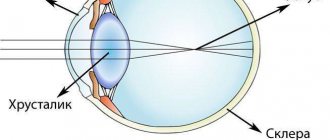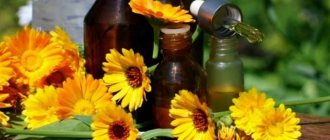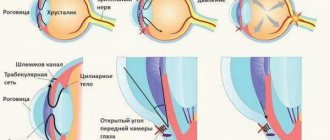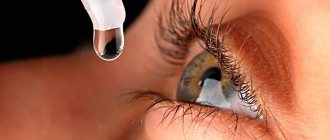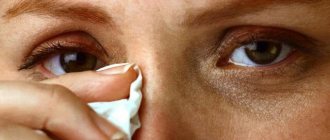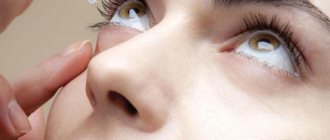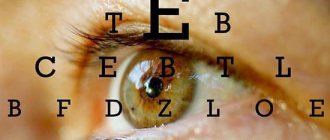The effectiveness of herbs for treating eyes and vision
Many herbs and flowers contain beneficial substances that are natural. This reduces the risk of developing adverse reactions that occur when taking medications.
The composition of herbal preparations includes the following beneficial substances:
- vitamins, microelements, minerals;
- enzymes;
- antibiotics of natural origin;
- alkaloids.
To achieve the correct effect, the herbal remedy must be prepared correctly:
- Infusions. Flowers or herbs are poured with boiling water and infused without boiling. During this time, all useful substances are released into the liquid. After infusion, it should be strained and used.
- Decoctions. They are cooked for no more than 10 minutes. This technique is used when the herbal remedy does not release its beneficial substances through infusion. After boiling, the liquid is cooled to room temperature, filtered and used.
- Tinctures. The herbs are poured with alcohol or vodka and infused for a long time. It usually takes about 1 month. There is no need to strain the liquid, as with further infusion it acquires beneficial qualities.
The beneficial properties of most plants have been proven through clinical trials. They have anti-inflammatory, antibacterial, soothing and many other effects. Often used to reduce the progression of myopia and farsightedness.
↑ EYE BATHS
Pre-purified water needs to be cooled slightly in the refrigerator and poured into a container the size of your face. Place your face in the water for 10-15 seconds, open your eyes slightly and blink at least a few times. Raise your head, blink and repeat the bath one more time or two. Do not set records, do not abuse contact with cold water. Even short-term interaction of your eyes with water will bring you great benefits and great results.
Some people cannot plunge their entire face into water: they are either afraid of it, or cannot hold their breath even for a short period of time. In such cases, you can use special glasses, regular spoons, or just your own palms. It is only important not to violate the main rule: the water should be clean and cold, contact with it should be short-term, and the method of performing the procedure should be comfortable for you. The total duration of the procedure is 15-30 seconds. In addition to the purely hygienic effect, an equally important effect is the stimulating and tonic effect of cold water.
Our thermoregulation mechanism reacts to an arbitrary change in temperature in some part of the body in the same way: a flow of heat rushes to the cooled area. And this warming wave provides an influx of nutrients, increases blood circulation in this area, cleanses and strengthens the walls of blood vessels, enhancing microcirculation and metabolism in them.
All this has a very beneficial effect on the eyes themselves, and on the blood vessels of the eyes, brain and face. Among other things, baths tone and rejuvenate the skin, protecting it from painful reactions to temperature changes, cold, heat, wind and snow. Only the use of this procedure sometimes led to the fact that people stopped suffering from seasonal runny noses and colds, and got rid of photophobia and lacrimation.
By lowering our face into the water, we involuntarily hold our breath for these seconds, and by raising our head out of the water and taking an involuntary breath, we activate the flow of oxygen to the head and eyes, which is also extremely important for our vision. Even performing this procedure twice a day will be of great help for people with a wide variety of refractive errors.
You will help your vision even more if you introduce eye stimulation into your life with cold and hot water, again, of course, clean.
Precautionary measures
Herbal remedies should be taken with caution, it is recommended to consult your doctor first, their use may cause some side effects:
- prolonged use of alcohol tincture can negatively affect liver and kidney function;
- many herbs and flowers can cause a severe allergic reaction;
- The use of herbal remedies is not recommended for pregnant women, some of them affect the growth and development of the fetus, others can cause sudden termination of pregnancy.
The herbal product is not recommended for allergy sufferers, as it may cause a cross-reaction.
What herbs treat eyesight?
Traditional medicine successfully uses medicinal herbs for vision, both on their own and in the form of herbal teas for the treatment of various chronic eye diseases, including: astigmatism, myopia, farsightedness, eyesight, glaucoma, cataracts, optic nerve atrophy, age-related visual impairment, hemeralopia (night blindness), etc. The sooner treatment is started, the greater the result can be achieved.
Belmo
A cataract (leukoma) is a persistent clouding of the cornea of the eye that occurs as a result of damage, inflammation or an ulcerative process. A thorn located opposite the pupil reduces vision, sometimes to the point of blindness. If the eyesore is not pronounced, then using herbs for the eyes helps restore vision.
Recipes Tajik folk medicine recommends using red onions to resolve cataracts, as well as to restore vision. Finely chop the onion, squeeze out the juice using gauze and mix with boiled milk in a 1:1 ratio. Place 1-2 drops in each eye. Carry out the procedure 1-3 times a week. Squeeze the juice from the flowering heads of red clover, strain through cheesecloth and mix with natural honey in a ratio of 2 parts juice and 1 part honey. Lubricate the eyelids with the resulting mixture 2-3 times a day or instill 3-5 drops.
Glaucoma
Glaucoma is an eye disease, the main symptom of which is increased intraocular pressure. If left untreated, it can lead to complete blindness.
Recipes 1 tbsp. pour 250 ml of cumin fruits. water, bring to a boil and simmer over low heat for 3-5 minutes. Remove from heat, add 1 tsp. blue cornflower flowers, cover with a lid, insulate and leave until cool. Strain through several layers of gauze. Instill 1-2 drops 1-2 times a day. 1 tsp. pour 250 ml of dill seeds. water, bring to a boil. Remove from heat, cover with a lid, insulate and leave until cool. Drink 1 tbsp. 4 times a day. The course of treatment is two weeks, then a break of 10 days and the course is repeated. During treatment with dill seeds, diuretics should be taken.
Cataract
Cataract is clouding of the lens. It develops mainly in older people as a result of malnutrition of the eye tissues. Other causes of the disease include: long-term chronic eye diseases (retinal detachment, myopia, glaucoma, inflammation of the choroid, etc.), diabetes mellitus, prolonged exposure to ultraviolet and infrared radiation, radiation, prolonged work at high temperatures, mechanical damage, etc. the cause of a sharp decrease in vision.
Herbs for myopia and farsightedness
To improve the quality of vision with myopia and hypermetropia, it is recommended to use herbal remedies. They help increase metabolism in the eyeballs, thereby increasing the rate of renewal of cellular composition:
- Blueberry leaves. They are prepared in boiling water in the proportion of 2 teaspoons of the plant to 1 glass of water. The leaves are infused for 1 hour, filtered. The product should be drunk ½ of a glass 2 times a day.
- Eyebright. It is used as a decoction, pouring boiling water for 3 hours. After the product has completely cooled, drink it ½ cup 2 times a day.
- Motherwort. The grass is poured with hot water, infused for 40 minutes, then decanted. It is recommended to take 1 tablespoon in the morning and evening.
- Cherry pulp. The berries are ground in a blender or mashed with a fork. The pulp is placed in gauze and placed on the eyelids for 20 minutes.
- Schisandra. A tincture is made from the plant, filled with alcohol or vodka. Take 1 part herb, add 3 parts alcohol. It requires insisting for two weeks. They drink drops, 20 in the morning, 20 in the evening.
It is recommended to use all herbal remedies in moderation, in the dosage prescribed by your doctor. If any side effect occurs, discontinue the drug immediately and consult a doctor. If an allergy occurs, take an antihistamine before going to a specialist.
What eye diseases are treated with herbs?
First of all, medicinal herbs for the eyes have proven to be highly effective for the treatment of inflammatory and infectious diseases, such as trachoma, blepharitis, keratitis, conjunctivitis, purulent discharge, inflammation of the lacrimal sac, lacrimation, barley, etc.
Also, medicinal herbs for vision are successfully used for chronic eye diseases: myopia, farsightedness, eyesores, glaucoma, cataracts, age-related visual impairment, etc. The greatest results are achieved in the initial stages of the disease.
Herbs are used to improve vision, both for treatment and prevention. In addition, they have found their use for problems such as puffiness under the eyes, dark circles, etc.
Herbs for vision in folk medicine
Traditional medicine uses the following plants for the treatment and restoration of vision, as well as for prophylactic purposes: quince, rose hips, bogwort, mint, elderberry, hawthorn, blue cornflower, nettle, wallflower, chamomile, fragrant honeysuckle, ginseng, dogwood, dill, raspberry , celandine, pigweed, thyme, cornflower, calendula (marigold), eyebright, dandelion, wildflower, wheatgrass, plantain, parsley, wild mallow, fennel, duckweed, motherwort, pigwort, aloe, tartar, sorrel, bird cherry, blueberry , pine, etc.
Dead, living water - treatment, my experience | DEIF
As it turned out, living (hydrogen) and dead water is a real clinic that treats inflammatory processes, arthritis, colds and ailments, runny nose, burns and wounds, kills viruses and even (miracle) toothache, and much more.
It all started with the fact that one day everyone in the family got sick in the winter, and then I remembered the material I had read on the topic - dead water, living water - treatment. There was no device for testing the experiment and preparing the miraculous liquid, and the author began to tinker with this device with gusto.
There were no platinum electrodes or “stainless steel” on hand, especially since it was difficult to go looking for all this with a snotty nose and fever. (It is highly recommended to read this article on the use of living (hydrogen) and dead (acidic) water in its entirety.)
How you can make your own device for making living and dead water is described in the second part of the article).
Gymnastics for the eyes
There are several simple exercises that will help train the eye muscles. It is these muscles that are responsible for accommodation, a process that determines the clarity of vision. This eye exercises must be repeated every day.
Gymnastics for the eyes
- With your fingers spread wide, bring your palms to your face. Imagining that your fingers are something like a picket fence, begin to make turns with your head. At this moment it is necessary to look not at the fingers themselves, but into the distance, through them. Such turns must be done 20-30 times, alternating as follows: three turns with eyes open, three with eyes closed.
- You need to imagine that there is a large sheet of paper right in front of you. Mentally draw a square in the upper corner of the sheet. Try to fit a circle into it, and a ball next to it. Then draw a rectangle with a horizontal long side. This exercise can be repeated several times a day.
- Stand up straight, stretch your arm forward in front of you and look at the tip of your middle finger. Start slowly moving your finger closer until it begins to double. Repeat the exercise 6-8 times.
- You need to blink quickly for 15-20 minutes.
- On the correct eyelid of both eyes, you need to lightly press with three fingers of each hand. Hold for 2 seconds. Repeat 3-4 times.
Useful video
You can learn more about folk methods of improving vision after watching these videos:
To improve vision, it is not at all necessary to take expensive medications or undergo physiotherapeutic courses of treatment. Simple and affordable products based on plant materials effectively improve a person’s ability to see surrounding objects. When used correctly, side effects are almost completely eliminated.
Author's rating
Author of the article
Alexandrova O.M.
Articles written
2031
about the author
Was the article helpful?
Rate the material on a five-point scale!
If you have any questions or want to share your opinion or experience, write a comment below.
Treatment of dry eyes with traditional methods
When your eyes hurt, folk remedies can come in very handy, as they are mostly accessible and effective. One way to get rid of dryness, relieve redness and fatigue is to take baths with a decoction of mint, chamomile, tea or parsley. You can rinse your eyes as follows: fill a glass with liquid, press it firmly to the eye and tilt your head back, and then blink several times, allowing the product to wash the mucous membrane.
Cornflower decoction
A product containing 2 tsp is suitable for rinsing. cornflower flowers, which must be poured with 250 ml of boiling water and left for an hour, and then strained. After cooling the infusion, wash your painful eyes with it. The folk remedy fights dryness and creates an additional antiseptic and anti-inflammatory effect.
Oak bark infusion
The healing properties of oak bark help with eye inflammation. Pour boiling water over some oak bark and place on low heat for 5 minutes. Leave to infuse for one hour and make baths with this product according to the method described above.
Cucumber gruel
Pour half a glass of boiling water over the same volume of dried and grated cucumber peel. After steeping and cooling, add a third of a teaspoon of baking soda to the product, mix and use to wash your eyes if they hurt due to dryness.
